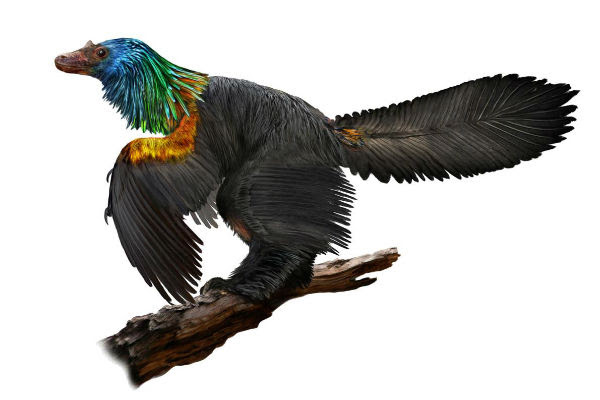There was an article in the New York Times recently about the evolution of birds, a field of knowledge that still has lots of mysteries. There are thousands of bird fossils, many of which have still to be fully examined and classified. But we are learning.
One of the more interesting is Caihong juji, an extinct species of dinosaur that lived during the Late Jurassic period, approximately 161 million years ago. It is known for its remarkable colorful plumage, leading to its popular nickname, “the rainbow dinosaur.” The scientific name translates to “rainbow with a big crest” in Mandarin Chinese.

The first fossil specimen of the “rainbow dinosaur”was discovered in a slab of rock in the Tiaojishan Formation in northeastern China. It was described and named in 2018 based on a nearly complete skeleton with well-preserved feathers. The fossil includes impressions of feathers that show a range of colors, including iridescent hues similar to those seen in hummingbirds.
Caihong juji belonged to the theropod group of dinosaurs, which includes famous carnivorous dinosaurs like Tyrannosaurus rex and Velociraptor, butwas a much smaller dinosaur about one meter (3.3 feet) in length. The therapoda is a dinosaur clade that is characterized by hollow bones and three toes and claws on each limb.
About the size of a duck, one of the most distinctive features of Caihong juji is its elaborate head crest. The crest is formed by long, ribbon-like feathers that extend from the back of its head. These feathers are thought to have served a display or signaling function, possibly for attracting mates or intimidating rivals.
The presence of iridescent feathers on the head, wings, and tail of Caihong juji is significant because it provides evidence that this kind of coloration evolved in dinosaurs long before the appearance of modern birds. The discovery of Caihong juji has shed light on the diverse and complex feather structures found in non-avian dinosaurs, furthering our understanding of the evolution of feathers and their functions. In 2011, samples of amber were found to contain feathers from 75 to 80 million years ago during the Cretaceous era, with evidence indicating that they were from both dinosaurs and birds. We know that the earliest feathers were not used for flight so it was initially suspected that they were used for insulation. Flight and insulation are certainly substantial functions in today’s birds, but what good did the
first feathers do as they were rather simple structures scarcely distributed on the body?
As more and more fossils were found it became apparent that many feathers were colored, leading to the hypothesis that the original function of feathers was communication. Caihong juji certainly supports that idea. Like birds today, color and patterns of feathers over the body serve to attract mates, defend territories, and/or provide cryptic coloration. Only later in the evolutionary process did feathers co-opt the functions of insulation and flight. The asymmetrical tail feathers of Caihong juji indicate it was a flyer, albeit not a good one.